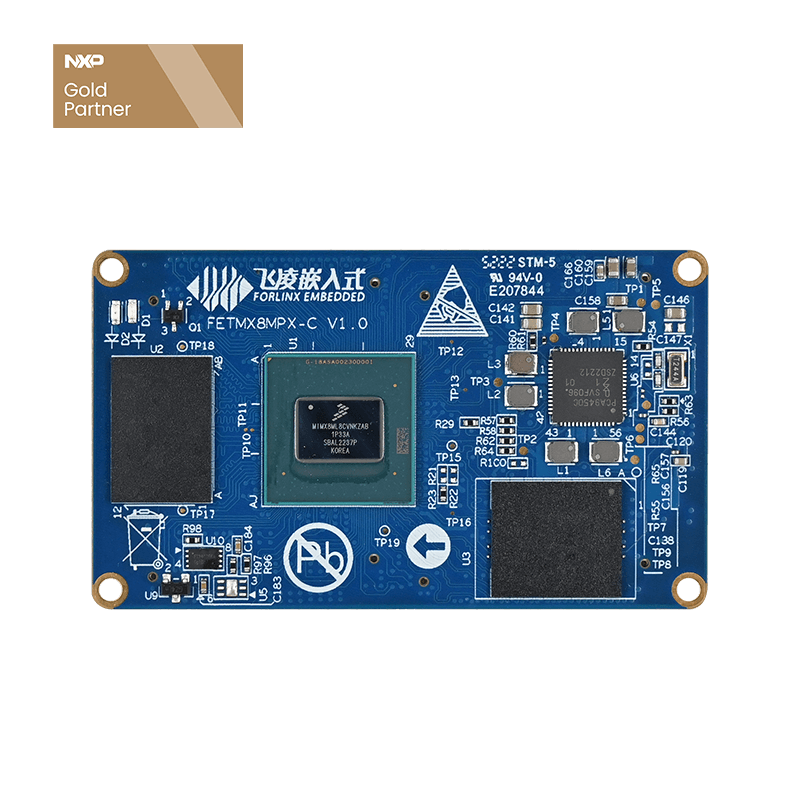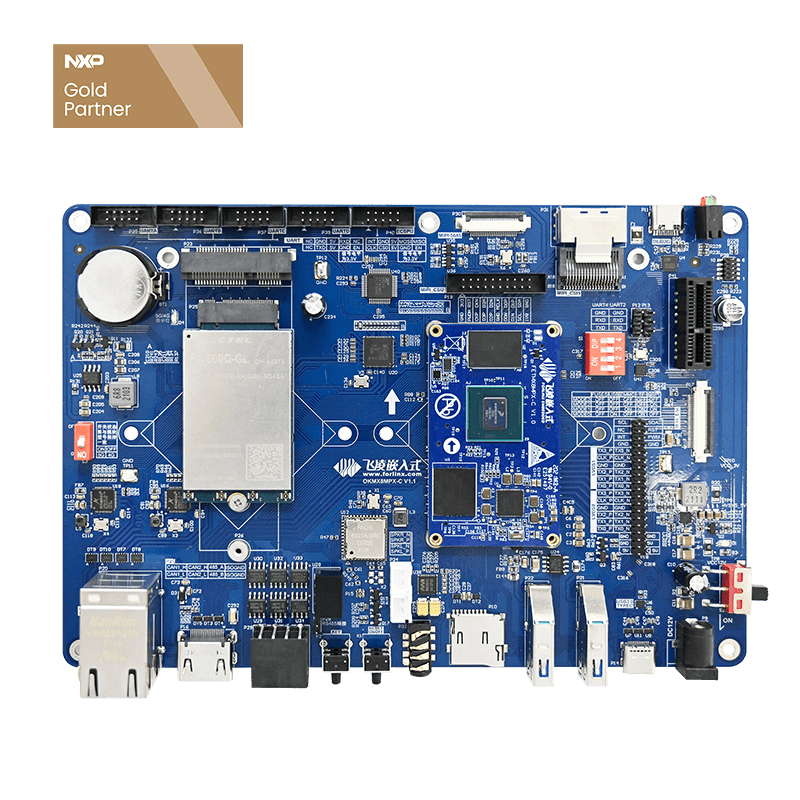
The Function Test of the i.MX 8M Plus Development Board
In August of 2021, Forlinx Embedded released a new OKMX8MP-C development board. Based on the NXP i.MX 8M Plus processor design, this board is known to all for this powerful processor. In addition to powerful quad or dual Arm® Cortex®-A53 processor (up to 1.6GHz in industrial grade) and one Cortex-M7 (up to 800 MHz) core, it also integrates a dedicated Neural Processing Unit (NPU) and an Image Signal Processor (ISP) that can be processed in parallel and in real time from two integrated MIPI-CSI camera interfaces.
OKMX8MP-C development board consists of two parts, that is, the FETMX8MP-C core board equipped with i.MX 8M Plus processor and the resource-rich baseboard. For user testing and development, the i.MX 8M plus development board provides a wide range of high-speed interfaces, including 2 USB 3.0, 2 CAN FD, 2 Gigabit Ethernet, 1 PCIe Gen 3, and more. In addition, it also has rich multimedia features, support for three-screen simultaneous and three-screen alienation (access to LVDS, HDMI, MIPI interface screens at the same time), HDMI support for up to 4K output. Supports 1080p60 frames, H.265 / H.264, VP9, VP8 video decoding, and 1080p60 frames, H.265 / H.264 video encoding. In order to let the vast number of engineer friends on the OKMX8MP-C development board have a more intuitive understanding, Forlinx's software engineers have chosen part of functions on this development board (core board) and made some functional and performance tests. Now, let's go into the body and start today's assessment.
NPU’s Functional Testing
i.MX 8M Plus processor with built-in NPU for 2.3 TOPS (Tera Operations Per Second, 1TOPS stands for processors that can perform a trillion operations per second) arithmetic processing and advanced AI algorithmic processing. And because of its low power consumption, it can be used in miniaturized products. The image below shows a comparison of calculus performance and power between the i.MX 8M Plus processor and similar platforms:
NXP provides specific use cases for CPUs i.MX 8M Plus processors, such as the ability to process more than 40,000 English words, and the MobileNet v1 model to process image classification of more than 500 images per second. Here are the test cases for MobileNet-ArmNN using the OKMX8MP-C board:
The above test case is to identify the next three pictures, the recognition is rendered in a coding manner, different encoding corresponding to different content, the value in the figure above is the probability of recognition.
As the first line corresponds to the meaning:
The probability of an object being identified as number 209 is 81.8154%, and so on.
Two-way Gigabit Ethernet Functional Test
The OKMX8MP-C board comes with a 2-gigabit Ethernet interface, where eth1 supports TSN (Time Sensitive Network) functionality. TSN is a next-generation network standard based on Ethernet, with time synchronization, delay guarantee, and other functions to ensure real-time. TSN uses standard Ethernet to provide distributed time synchronization and deterministic communication, which can be used in any application that requires distributed measurement or control. We can use TSN for simple distributed synchronous measurements, improvements in industrial CNC processing, new semiconductor processing machines, and grid research.
In addition, the two-way Gigabit Ethernet has high transmission performance and a low CPU footprint. Here's an iperf (a widely used network performance measurement and tuning tool) streaming test between the OKMX8MP-C board and the PC:
Test between the eth1 port and the PC
PC-side execution service side:
Clients of the OKMX8MP-C board:
Testing between the eth0 port and the PC:
PC-side execution service side:
Clients of the OKMX8MP-C board:
As can be seen from the above results, the base rate is 940Mbits/s, almost reaching the bandwidth limit.
Memory speed test
The FETMX8MP-C core board is equipped with 4GB LPDDDR4 industrial-grade memory particles, operating rate of up to 4.0GT/s, providing strong support for NPU machine learning and other applications. Let's use lmbench to test the memory speed. lmbench is a simple, portable, ANSI/C-compliant, miniature assessment tool for UNIX/POSIX. In general, it measures two key characteristics: reaction time and bandwidth. The reading and writing speed of the LNDDR4 was tested using bw_mem command under Lmbench:
The first half of rd is the read test of the tested LPDDR4, and the second half of the wr is the write test of the tested LPDDR4.
In the figure above, the first column means that the data size of the test is 52.43 Mbyte, and the second column means the speed of reading and writing, which is about 2981 Mbyte/s. Similarly, the write speed is about 1338Mbyte/s.
5G communication test
OKMX8MP-C board supports 5G communication modules, so let's test 5G network speed (5G_SA standalone networking) using software such as speedtest CLI.
As follows, the platform interface performance and the different geographic connection speeds of the 5G communication module were tested using supersbench:
The I/O Speede above is the write performance of the EMMC, read performance is not reflected in the test, there are specific tests in the product manual.
Here's the 5G network speed tested by the Speedst test tool:
As shown in the figure, the downlink speed of 500Mbps is measured in a more enclosed indoor environment. Because network speeds in different regions may be affected by carrier base stations, the data here is for informational purposes only.
Above is the full content of this assessment, it is worth mentioning that OKMX8MP-C also has many featured interfaces, including 2 ISP-enabled MIPI camera interface, maximum resolution support to 4096 x 3072, free-scalable PCIe Gen 3 and 2 lans CAN-FD and so on.



